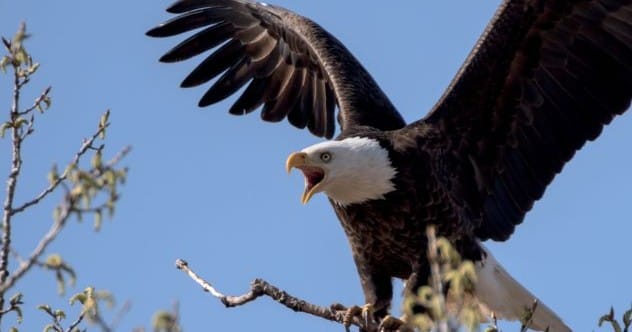Birds are truly fascinating creatures, but many persistent myths and misconceptions surround them. These misunderstandings can influence how we see and interact with our feathered friends. Let’s explore and debunk some common bird myths, separating fact from fiction to deepen your understanding of the avian world.
Prepare to rethink what you thought you knew about our winged companions!
Ostriches Stick Their Heads in the Ground
Despite cartoons, ostriches don’t bury their heads in the sand when scared.
This myth traces back to ancient Rome, when Pliny the Elder described ostriches thrusting “their head and neck into a bush, that the whole of their body is concealed.” He was partially right; ostriches dig holes to bury their eggs. Observers might have seen them checking on their eggs and assumed they were hiding.
Interestingly, ostriches deal with danger by flopping to the ground to blend in with the terrain.[1]
Owls Can Turn Their Heads 360 Degrees
Owls are known for their exceptional sight and hearing, but they can’t turn their heads a full 360 degrees, as depicted in cartoons. Their fixed eye sockets require them to turn their heads to see around them.
However, they can turn their heads up to 270 degrees, which is still impressive! A complete spin would break blood vessels or tear tendons.[2]
Eugene Schieffelin Released Birds from Shakespeare’s Works
In the 1890s, Eugene Schieffelin released 60 starlings from London into Central Park. At the time, introducing non-native species wasn’t known to be harmful.
Legend says this was part of a plan to introduce every bird mentioned in Shakespeare’s plays to North America. Historians doubt this, with no evidence until the 1940s when naturalist Edwin Way Teale proposed the theory. Another theory suggests that Schieffelin got the idea from Central Park’s Shakespeare Garden, but that garden was created after his death.[3]
Parrots Can Talk
Parrots can mimic human sounds, resembling words and phrases, but they don’t “talk” in the traditional sense.
They repeat what they hear, associating it with situations. For example, they might say “hello” when someone enters a room because they’ve heard it before.
If your parrot calls you names, it doesn’t mean to be hurtful; it’s simply repeating what it has heard.[4]
Rice Can Kill Birds
The tradition of throwing rice at weddings has declined due to the myth that it harms birds. The myth suggests that raw rice expands in their stomachs, killing them. While rice does expand, birds’ digestive systems can handle it.
Many birds eat grains like rice in the wild. Wedding venues often ban rice due to the mess it creates, more so than concern for the birds.[5]
Owls Are Extremely Intelligent
Characters like Owl from Winnie the Pooh suggest owls are highly intelligent, but that’s not entirely true.
Unlike crows and pigeons, owls aren’t easily trainable and can be stubborn. Experts believe they lack the brainpower seen in birds that imitate calls or associate objects with words. We associate them with intelligence because their forward-facing eyes give them a human-like appearance, making us think they’re listening.
While owls are smart in their way, particularly in hunting, they aren’t top of the class in human-like intelligence.[6]
Humans Can’t Touch Baby Birds
If you find a baby bird that has fallen, you can help it back into its nest without fear of the mother abandoning it.
The myth that mother birds will abandon their young if touched by humans is false. Wildlife experts confirm that almost no animals abandon their young based on human smell.
Birds have a weak sense of smell. Disturbing their home is more likely to cause abandonment, as they may leave if their nests are messed with or destroyed.[7]
Bald Eagles Sound Powerful
The bald eagle is the national symbol of the United States, but the iconic screech associated with it isn’t the sound these birds make.
Like Disney using tiger roars for lions in The Lion King, TV shows and movies often substitute bald eagle cries with red-tailed hawk sounds. The eagle’s actual call wasn’t considered majestic enough, and the hawk’s call took its place. Bald eagles make a weak, high-pitched whistle, similar to a seagull’s scream.[8]
Feeding Birds in the Fall Prevents Migration

It’s fine to feed birds year-round, despite the belief that it will prevent them from migrating.
Birds migrate to warmer climates in the fall for warmth and resources. Some believe feeding them keeps them in the area until it’s too late. However, migrating birds leave for more sunlight, not just food. They will always leave when days shorten, regardless of available food.
Feeding birds in the fall can help them by allowing them to store energy for their journey.[9]
Dodos Were Dumb
Dodos had intelligence above the average bird.
Despite their appearance, dodos are related to pigeons, known for intelligence and trainability. The jokes about their stupidity aren’t accurate.
Dodos evolved without significant predators, leading them to have no fear of humans. This, combined with their inability to fly, made them easy to catch and eat. Reports indicate they would approach seamen, leading to their easy demise.[10]
From debunking the myth of ostriches burying their heads to understanding that dodos weren’t actually dumb, we’ve uncovered some fascinating truths about birds. Hopefully, this exploration has deepened your appreciation for these amazing creatures.
What surprised you most? Leave your comments below!










